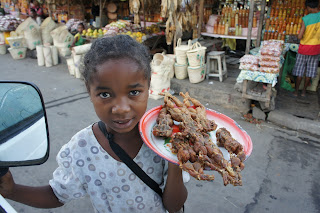So I've included this informative little map to assist you in tracking my journey in this post. I start out in Diego-Suarez at the north end of the island. Head south, past the turnoff to Mahajanga (white star on the west coast), and continue to Antananarivo, the capital at roughly 4,000 feet above sea level (same as Provo, UT).
Wednesday morning I had set my alarm fairly early to try and make it out to Joffreville and back before 3pm for the bus to Tana. But I slept through it and didn’t wake up until 8. Joffreville, I was told, was a 2 hour bus ride one way and is the entrance to Parc National de Montagne D’Ambre (Amber Mountain National Park) which basically is a giant rainforest mountain filled with lemurs and waterfalls. Since it was already 8, I was afraid I wouldn’t make it, so I decided to just chill in Diego. I had some breakfast and chatted with the reception girls who were always very friendly and more than happy to teach me Sakalava (the local dialect). They showed me cocoa beans and a konikony (the fruit I ate on the bus to Ramena the day before).
I wrote my first couple blog entries and uploaded some pictures which took most of the rest of the time I had in Diego.

When I showed up to the taxi-brousse station (to go back to Tana) the bus was not ready to go (typical) so I paid a taxi guy to drive me to a lookout spot so I could snap some pictures of Nosy Lonjo (Pain des Sucres in French). On the way I got some shots of
The Cathedral
Typical bright yellow Diego taxi
The Stadium
A cemetery – which I started taking pictures of thinking “oh cool!” and then thought “wait, why is it cool to see a cemetery?” and then realized “oh yeah, they don’t use cemeteries in Madagascar, I’ve only seen like 2 in the whole country” (Malagasies bury their dead in tombs for the most part).
Finally we got to the lookout and I got my coveted pictures:
Nosy Lonjo is the name of the island in the middle of the bay, and is featured on the Ariary Zato (100 Ar) bill.
Got back to the bus station and they still weren’t ready to go. There was a lot of squawking about someone who hadn’t shown up, and someone who double sold seats, and how there weren’t enough seats for everyone…
This is what a taxi-brousse looks like:
The driver plus two people sit in the front and then 3 people per row with usually 3 or 4 rows in the back. This particular van had 4 rows. Making a total of 14 passengers plus the driver.
This is the ticket office. Apparently this company runs busses from Diego to Tana, Mahajanga (12-20 hours), Toamasina (30-36 hours), Tulear (48 hours) and Fort Dauphin (probably close to 80 or 90 hours – which is absolutely the most ridiculous experience I could possibly imagine).
While I was waiting I took pictures of the local people / passengers. The guy on the right is what is called a metis. Most likely his dad is some French dude and his mom is a Malagasy. Anyways, he looks like he could fit right in in America, but he speaks and acts just like any other Malagasy. He, along with a bunch of other college kids were on my bus en route to Tamatave to start or end (never really understood what they meant) school.
These lovely ladies are sisters (far left and far right) and they run the ticket office. They were quite friendly. I was really trying to get a picture of the lady in the middle a little farther back because she looks like Izma from The Emperor’s New Groove and she had a crazy outfit on. If you look around the picture you’ll notice many of the women are wearing cool African-esque outfits, which is one of reasons I thought Diego is so cool.
We finally got on the road around 4 or 5pm.
This yellow bus is a “camion-brousse” (bush truck) which is like the most hauss form of transport in Madagascar. These bus/truck/deathmobiles service the particularly remote/inaccessible towns. If you’re looking for comfort, speed, timeliness, or predictability – get out now! However, if you need to get anywhere besides the major towns on the major “highways” then this is probably your only option.
Driving through the Diego countryside as the sun was setting I took a few pics:

The next morning we arrived in Ambondronimamo (The Drunken Flock) [also the turn off to Mahajanga] where we got some “breakfast” and people paid 10 to 50 cents to pee, poo, and take a shower in relative luxury (aka cement cells). This is the local fruit/trinket market.
Malagasies are the kings of trying to sell things to travellers through van windows. This 10 year old girl and her plate of fried frogs were no exception. (No I didn’t buy one).
The scenery on the way back to Tana was as spectacular as it was on the way to Mahajanga – red dirt, rolling green hills, grey mountains, and blue blue skies.



I love Malagasy store names: “The Ideal Relax” lol also caters to Muslims. They actually make pretty dang good laoka (meat & beans that goes on top of rice) here.
Question #10 (and the whole reason I came up with the “Answers to Questions You’ve Never Asked” series) When you combine ketchup and mayonnaise, does it make Ketchaise?...
Answer: No. It’s called Mayo-Chup. Duh-face.
The bottom roughly translates as "Puts the Magic in your Plate!"







































Awesome entry! Makes me miss our trip to Canada... and looking for poutine
ReplyDeleteOr fry sauce.
ReplyDeleteThis is cooool.
This comment has been removed by the author.
ReplyDeleteBryce, Easton and I had fun reading this!
ReplyDelete